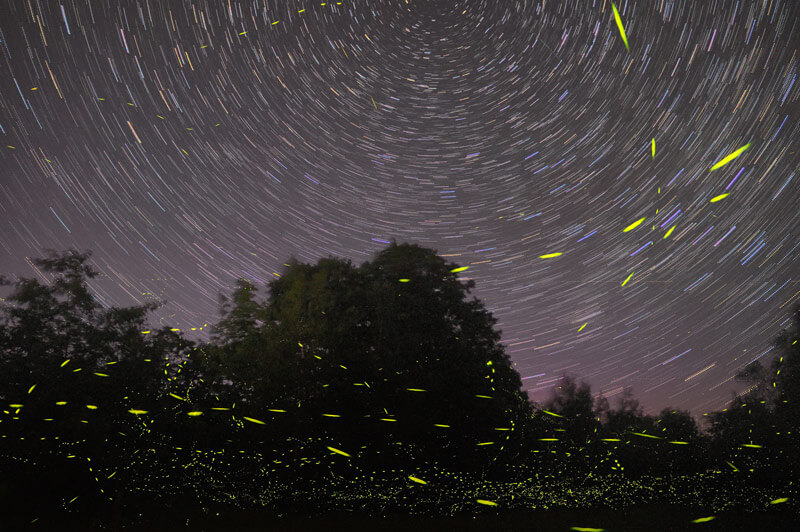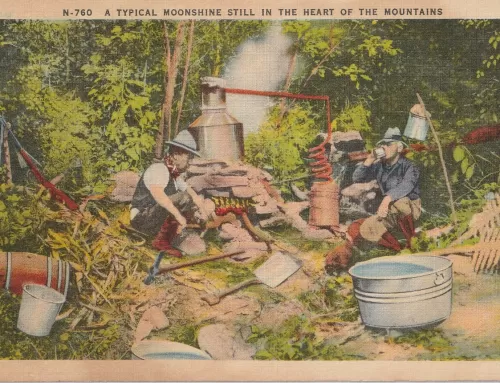The glinting glow of fireflies on a warm summer night stirs our imaginations and the curiosity of childlike wonder. Watching their lights flicker intermittently in the darkness is an enchanting delight, but have you ever seen them light up in unison? Firefly season is upon us, and with it comes the opportunity to witness a rare and otherworldly phenomenon that only occurs once a year – and only in certain parts of the world.
Every summer – for a couple of extraordinary weeks – the secret world of fireflies opens up under cover of darkness, and we mere humans have a rare opportunity to observe one of nature’s wildest nighttime displays. The synchronous fireflies that live in the Elkmont region of the Great Smoky Mountains National Park (one of at least 19 different species) begin to flash in unison, and you can watch it happen up close and personal, like an immersive art show.
What are Synchronous Fireflies?
Synchronous fireflies – or lightning bugs, depending on what region of the country you’re from – are a unique species of beetles that synchronize their flickering light patterns. As part of an awe-inspiring mating ritual, the male fireflies fly around and flash their “lanterns,” located on their abdomens, to attract the more stationary females, who respond with a flirty flash of their own.
The peak firefly mating season typically lasts for around two weeks each year, ranging from the end of May to the beginning of June. Exact dates as well as the light display itself can vary depending on factors like temperature, rainfall, and even moisture in the soil. The twinkling exhibition is less likely to happen at its fullest glow, for example, if the temps fall below 50 degrees at night.
Where and When to See The Fireflies in the Smokies
This magical experience is one of the most magically thrilling things to do in the Smoky Mountains. But with light pollution like car headlights and flashlights, there is the risk that the fireflies won’t take part in their flashing mating ritual, which means there won’t be a new generation of fireflies. In order to protect this awe-inspiring species, the park puts a limit on the number of visitors.
Every year there’s a lottery system to obtain the coveted parking passes required to attend the firefly viewing. The lottery typically opens every April, and applicants will be notified if they’ll be awarded a parking pass. Lottery winners will be charged a $20 – $25 reservation fee to help cover the cost of supplies and park personnel.
In 2020, the public event was canceled because of the COVID-19 virus. But a live, online event was held and recorded on YouTube.com, and it is something to behold. (Firefly views start at the 14:15 mark.)
Although Elkmont is the most popular area to watch the fireflies, you can also spot them in many of the park’s open fields that are bordered by thick tree lines and water. And there are other options like private tours, guides who take you camping, or the Cataloochee Valley Tour in Waynesville, North Carolina that offers a nighttime hike into the park for spectacular views of the fireflies. But no matter where you are, get ready for the big show starting around 10 pm and ending around midnight, just like a fairytale.
Local Tips for Firefly Viewing:
Because fireflies require total darkness to mate, the park strictly prohibits the use of any type of light that may disturb the fireflies. Make sure you:
- Cover your flashlight with red or blue cellophane
- Use your flashlight only when walking to your viewing spot
- Stay on designated trails or paved surfaces at all times
- Point your flashlight at the ground
- Turn off your flashlight when you find your viewing spot
- DO NOT try and catch the fireflies
Fun Facts about Fireflies:
Fireflies are neither a fly nor a bug. They are actually beetles.
There are more than 2,000 species of fireflies around the world.
Fireflies are on every continent except Antarctica.
Each firefly species has its own special flash pattern—a code that lets individuals identify a mate of the same species.
Not all fireflies flash. Instead of light, these “dark” fireflies use smells like pheromones to communicate and find their mate.
Firefly femme fatales lure unsuspecting males of other species to their deaths.
The biggest fireflies can grow to be the size of your palm.
To learn more about fireflies in the Smokies, plus other things to do like finding food, flowers, and foraging, check out the Gateway to the Smokies podcast with Joseph McElroy.
Visit the Gateway to the Smokies podcast to learn more about fireflies, flowers, and food in the Smoky Mountains!




